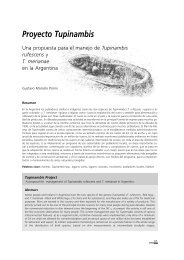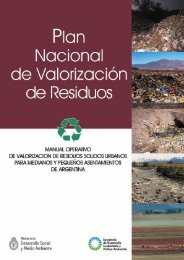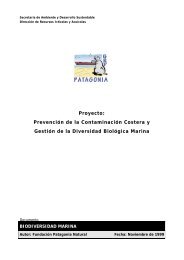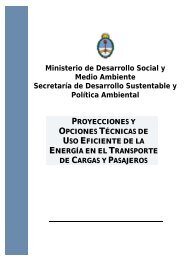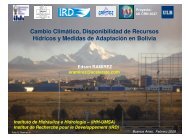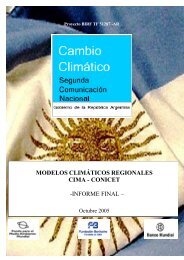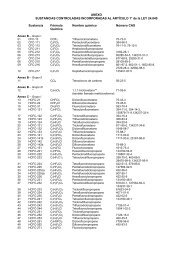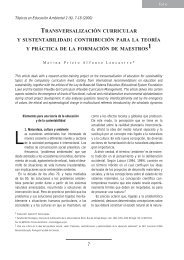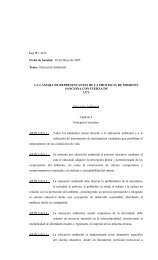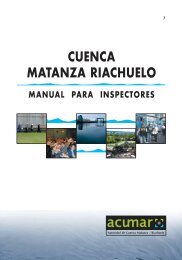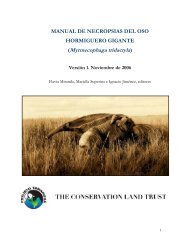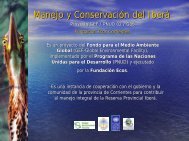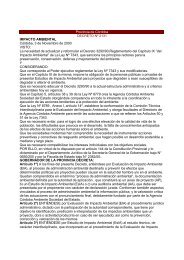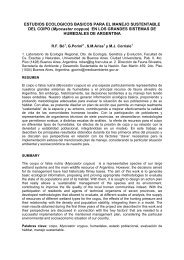Coypu Project - Secretaria de Ambiente y Desarrollo Sustentable
Coypu Project - Secretaria de Ambiente y Desarrollo Sustentable
Coypu Project - Secretaria de Ambiente y Desarrollo Sustentable
Create successful ePaper yourself
Turn your PDF publications into a flip-book with our unique Google optimized e-Paper software.
Management of wild life in ArgentinaThe results obtained from the application ofthese three mo<strong>de</strong>ls showed differentscenarios. Contrary to age structure analyzedabove and its probable relation to relativelyintense and persistent hunting activities,according to the MSU (and the intrinsic ratesof estimated growth) coypu populations wouldbe hardly susceptible to local extinctions.However, it is observed a slight <strong>de</strong>creasingten<strong>de</strong>ncy (or smaller increment) in their sizes(Nazar Anchorena, 2004), due to the fact thatthe generational time is relatively longer thanthe one mentioned by other authors (Kinler etal., 1987).In turn, just as Bodmer (personalcommunication) suggests in his Mo<strong>de</strong>l ofUnified Crop, the simultaneous analysis of theresults provi<strong>de</strong>d by the MCO and the MRShint that there would be an excessive huntingactivity in at least in 40% of the coypuexploitationareas of the country. However, insome of these cases such activity would be“concealed” by “compensatory” effects of thestill broad habitat availability in most coypuexploitationareas, as well as the prominentreproductive, distributional and colonizationcapacities of the species (Bó et al., in press).Nevertheless, it should be kept in mind thatthe mentioned compensatory factors couldstop being effective if there appears anynatural or anthropic factors so far ignored,such as illnesses, modifications in thehydrologic state caused by floods (Bó andMalvárez, 1999), “extraordinary” droughtsand/or implementation of infrastructural worksfor the management of water (Bó andQuintana, 1999). These events would bringabout negative or at least uncertainconsequences for the species and the humancommunities that live on its exploitation.e) Evaluations of the physical conditionand the sanitary state of the specimens.In or<strong>de</strong>r to <strong>de</strong>scribe the physical condition orthe general state of the specimens comingfrom the different areas un<strong>de</strong>r study, wecalculated an in<strong>de</strong>x of condition as proposedby Bailey (1968) and used by Willner et al.(1979) for the M. coypus. This in<strong>de</strong>x is basedon the existing relation between weight andcorporal size of the specimen and it can rangefrom 0 to 10. It was observed that, in almostall the coypu-exploitation areas of the country,<strong>de</strong>spite the eventual numerical compensationthat could arise from year to year, the physicalcondition of the specimens would be<strong>de</strong>teriorated. This can be closely related toexcessive hunting activity <strong>de</strong>tected by themo<strong>de</strong>ls of sustainability, as already <strong>de</strong>scribed.The mean value of the in<strong>de</strong>x of conditionturned out to be relatively low (M = 3.61;range 2.34-5.59) if it is compared, forexample, with the values collected in a placewhere the coypu does not un<strong>de</strong>rgo huntingpressure (see sections below). The lowestvalues observed correspon<strong>de</strong>d to thoseplaces with the greatest historic intensities ofhunting pressure. (Bó and Porini, 2003;Corriale, 2004).An analysis of fecal matter and viscera (liverand intestines) of most of the specimenscaptured was carried out in relation to theirsanitary state. As already mentioned inprevious works Moggia, 1981; Colantoni,1993), it was observed a particularly diversepresence of parasitic fauna, among which it isworth highlighting the digenea of the genusHippocrepis, Athesia and Taxorchis and somecestoda species, still in the phase ofi<strong>de</strong>ntification. It is also important to remark theabsence of Fasciola hepatica in all thespecimens examined (Galvani, personalcommunication).f) Analysis of the situation of the coypu inperiurban wetlands without presentexploitation activities.As an important complement to the activitiesbeing implemented in the main coypuexploitationareas of Argentina, it wasanalyzed the situation of the coypu in theBiosphere Reserve Laguna Oca of theParaguay River (Bó et al., 2004). This reserveis located in the province of Formosa. Themethodologies applied were similar to those<strong>de</strong>scribed for the PAs for coypu-exploitation.The evaluation of the past and presentsituation of the coypu in such reserve turnedout to be useful since this is a protected areathat allows human presence and is locatednext to a <strong>de</strong>nsely populated city (Formosa),inserted in the valley of floods of the Paraguayriver (CMA,- 6 -



